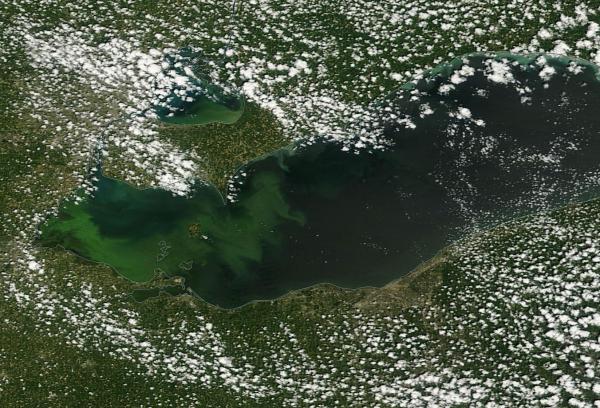The Hothouse Breeds More Toxic Waters — Lake Erie ‘Painted Green’ By Enormous Algae Bloom
6
August,2015
Enormous
blooms of algae painting the waters green, sickly blue, or blood-red.
Algae producing toxins making water unsafe to drink or swim in.
Making fish, shellfish and crabs unsafe to eat. Generating
life-snuffing dead zones of low oxygen and, potentially, producing
deadly hydrogen sulfide gas ranging our lakes, seas, and oceans.
This
is what happens when the world is forced to warm, when run-off due to
climate change induced extreme rainfall events increases, when the
land that run-off comes from is loaded with fossil fuel based
fertilizers, and when fossil fuel burning itself generates a constant
fall-out of nitrogen from the skies. In ancient hothouse events,
similar forces generated mass extinctions in the world’s waters.
And through fossil fuel burning we’re setting off a related
hothouse type stress to the life-giving liquid we all rely upon. A
stress that is yet worsened due to the efficiency with which we are
able to load the air, land, and seas with environmental toxins that
aid in the generation of algae blooms of an intensity nature alone
would have never kicked off.
(In
a human-warmed world, toxic algae blooms that threaten Toledo,
Cleveland and Akron water supplies are becoming all too common. Algae
biomass graphic for the 2013 and 2014 Lake Erie algae blooms provided
by NOAA.)
Lake
Erie in the Firing Line
In
the US, one
of the most vulnerable bodies of fresh water to this kind of toxic
algae growth is Lake Erie.
Over recent decades as the local climate changed, the water warmed.
Weather patterns resulted in increased heavy rainfall events.
Increased farm industry and fertilizer use meant that much of the
run-off was heavily laden with algae food. And the atmosphere itself
became loaded up with nitrogen. In addition, the lake is more
vulnerable to a life-snuffing stratified state in which the top and
bottom layers fail to mix. A final blow came from an invasive species
of mollusk — the zebra mussel — which
changed the food web in such a way that it favored the growth of the
toxic algae we see today.
All these factors combined to make the surface waters more and more
vulnerable to large, toxic algae blooms and the follow-on formation
of dead zones.
Since
the mid 1960s, late summer algae blooms have been a regular
occurrence on the lake. But more and more now, the blooms are
prolific enough to threaten city water draws.
In
2011, Lake Eerie suffered its worst algae bloom on record. At that
time, fully 20 percent of the lake was covered in the toxic stuff.
Then, both Ohio and Canadian cities along the lake had to shut off
water intakes to prevent toxins entering the water system. During
2014 the blooms had again threatened water supplies forcing Toledo to
shut its valves. Now, a new algae bloom is threatening Cleveland,
Toledo and Canadian water supplies. And, according
to NOAA officials,
the current bloom may be nearly as intense and widespread as the 2011
event. NOAA
notes:
The bloom will be expected to measure 8.7 on the severity index with a range from 8.1 to potentially as high as 9.5. This is more severe than the last year’s 6.5, and may equal or exceed 2013, which had the second worse bloom in this century. The severity index runs from a high of 10, which corresponds to the 2011 bloom, the worst ever observed, to zero.
Toxic
Algae Visible From Satellite
As
of yesterday, the widespread bloom of toxic algae was plainly visible
in the LANCE MODIS satellite shot:
(A
large and growing toxic algae bloom in Lake Erie visible from
satellite on August 5. It’s a bloom that may eventually prove to be
the largest such event on record for the Lake. Image source: LANCE
MODIS.)
A
huge swath of the western end of the lake was covered with the stuff
as of August 5, 2015. A clearly visible green blob blanketing much of
Erie’s western surface. Researchers
out on boats monitoring this year’s outbreak described the lake as
being painted in a thick sheen of goop.
According
to NASA,
the particular kind of algae that now appears annually in Lake Eerie
is called Microcystis.
It produces a toxin that is highly dangerous to humans. If consumed,
Microcystis may cause numbness, nausea, dizziness, vomiting, lead to
liver damage and even result in death. One part per billion in water
is all it takes to hit unsafe levels. And boiling toxin-laced water
is no remedy — resulting in further concentration of the dangerous
stuff.
During
August of 2014, unsafe levels were reached at Toledo intakes causing
water officials to shut down the lake water supply there. This year,
officials are closely monitoring the water supply ready to hit the
off switch if the water again hits a dangerous threshold.
Sadly,
Lake Erie isn’t the only place on Earth suffering the impacts of
hothouse-spurred toxic algae blooms. In the Pacific Ocean, a
massive blob of hot water is hosting a red tide of record depth and
extent.
That particular bloom risks the expansion of an already large dead
zone, the proliferation of anoxic and hypoxic waters, and the
potential for bottom water production of toxic hydrogen sulfide
producing bacteria. In
the North Atlantic, swirls of algae blooms are generating mobile dead
zones even
as the far North Atlantic is witnessing a massive blue-green algae
bloom (more on these dangerous human warming related events in
upcoming posts).
Links:
Hat
Tip to Andy in San Diego
Hat
Tip to Colorado Bob





No comments:
Post a Comment
Note: only a member of this blog may post a comment.